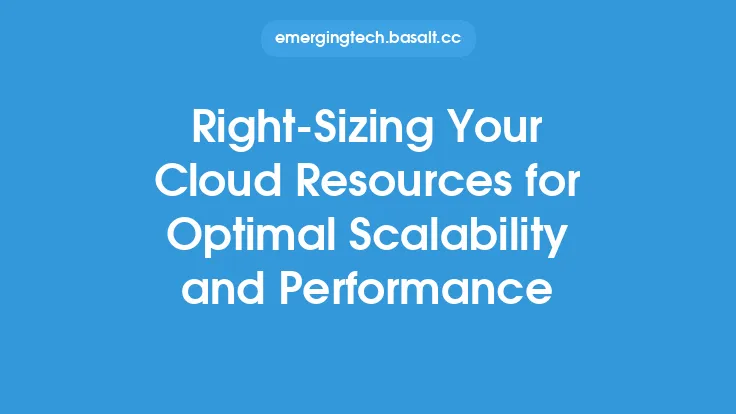Right-sizing your cloud resources is a critical aspect of cloud cost optimization, as it enables businesses to match their resource utilization with actual workload demands. This approach helps to eliminate unnecessary expenses, reduce waste, and improve the overall efficiency of cloud deployments. In this article, we will delve into the best practices for right-sizing your cloud resources, exploring the key considerations, benefits, and technical aspects of this optimization strategy.
Introduction to Right-Sizing Cloud Resources
Right-sizing cloud resources involves analyzing and adjusting the allocation of computing resources, such as virtual machines, storage, and databases, to ensure they align with the actual needs of an application or workload. This process requires a deep understanding of the workload's performance characteristics, usage patterns, and scalability requirements. By right-sizing cloud resources, businesses can avoid over-provisioning, which leads to wasted resources and unnecessary costs, and under-provisioning, which can result in performance issues and downtime.
Benefits of Right-Sizing Cloud Resources
The benefits of right-sizing cloud resources are numerous and significant. Some of the most notable advantages include:
- Reduced costs: By eliminating unnecessary resources and matching utilization with actual demand, businesses can significantly reduce their cloud expenses.
- Improved performance: Right-sizing ensures that workloads have the necessary resources to perform optimally, resulting in better application performance and user experience.
- Increased agility: With right-sized resources, businesses can quickly respond to changing workload demands, scaling up or down as needed to maintain optimal performance.
- Enhanced security: By minimizing the attack surface and reducing the number of unused resources, right-sizing can help improve the overall security posture of cloud deployments.
Key Considerations for Right-Sizing Cloud Resources
To effectively right-size cloud resources, businesses must consider several key factors, including:
- Workload characteristics: Understanding the performance, scalability, and usage patterns of workloads is crucial for determining the optimal resource allocation.
- Resource utilization: Monitoring resource utilization patterns, such as CPU, memory, and storage usage, helps identify areas where resources can be optimized.
- Scalability requirements: Businesses must consider the scalability requirements of their workloads, including the need for horizontal or vertical scaling, to ensure resources can be adjusted accordingly.
- Cost and budget constraints: Right-sizing must be done within the context of cost and budget constraints, ensuring that optimized resources align with business objectives and financial goals.
Technical Aspects of Right-Sizing Cloud Resources
From a technical perspective, right-sizing cloud resources involves several key aspects, including:
- Resource monitoring and analytics: Utilizing monitoring and analytics tools to track resource utilization, performance, and other key metrics is essential for identifying optimization opportunities.
- Automation and orchestration: Leveraging automation and orchestration tools, such as scripts, templates, and workflows, helps streamline the right-sizing process and ensure consistency across deployments.
- Cloud provider features: Cloud providers offer various features, such as auto-scaling, load balancing, and resource optimization tools, that can be leveraged to support right-sizing efforts.
- Containerization and serverless computing: Adopting containerization and serverless computing models can help businesses optimize resource utilization and reduce waste, as these models provide more granular control over resource allocation.
Best Practices for Right-Sizing Cloud Resources
To ensure successful right-sizing of cloud resources, businesses should follow several best practices, including:
- Implementing a continuous monitoring and optimization process to ensure resources remain aligned with changing workload demands.
- Utilizing automation and orchestration tools to streamline the right-sizing process and reduce manual errors.
- Adopting a cloud-agnostic approach to ensure right-sizing strategies can be applied across multiple cloud providers.
- Considering the use of reserved instances, spot instances, and other cost-optimization strategies to further reduce costs.
- Establishing clear cost and budget constraints to guide right-sizing efforts and ensure alignment with business objectives.
Common Challenges and Pitfalls
Despite the benefits of right-sizing cloud resources, businesses may encounter several challenges and pitfalls, including:
- Lack of visibility into resource utilization and performance metrics, making it difficult to identify optimization opportunities.
- Insufficient automation and orchestration capabilities, leading to manual errors and inconsistencies.
- Inadequate consideration of workload characteristics and scalability requirements, resulting in suboptimal resource allocation.
- Failure to establish clear cost and budget constraints, leading to over-provisioning or under-provisioning of resources.
- Inability to adapt to changing workload demands, resulting in performance issues and wasted resources.
Conclusion
Right-sizing cloud resources is a critical aspect of cloud cost optimization, enabling businesses to eliminate unnecessary expenses, reduce waste, and improve the overall efficiency of cloud deployments. By understanding the key considerations, benefits, and technical aspects of right-sizing, businesses can develop effective strategies for optimizing their cloud resources. By following best practices, avoiding common challenges and pitfalls, and leveraging automation, orchestration, and cloud provider features, businesses can ensure their cloud resources are properly aligned with workload demands, resulting in improved performance, reduced costs, and increased agility.





